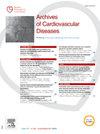护士从业人员在优化心力衰竭治疗中的作用日益扩大
IF 2.2
3区 医学
Q2 CARDIAC & CARDIOVASCULAR SYSTEMS
引用次数: 0
摘要
背景:在临床实践中,实现心衰(HF)的最佳护理仍然具有挑战性,很大一部分心衰患者没有接受指南推荐的治疗。目的探讨执业护士(NP)强化治疗管理在急性心衰患者出院后治疗管理中的作用。方法对187例连续住院的急性心衰合并LVEF和lt患者进行研究;2022-2023年我们心脏科的比例是50%分析患者是否接受了单独的心脏病专家或与NP相关的心脏病专家的经典随访,他们有资格提供患者教育和调整心力衰竭药物。在第一次出院后咨询和6个月后评估np增强随访对HF用药剂量(通过KCMO评分评估)与全因死亡率和HF再入院的综合结果的相关性。结果55例患者接受了NPs和心脏科医师联合监测,132例患者接受了心脏科医师单独监测。KCMO评分进展在“NP +心脏病专家组”中更为重要(ΔKCMO 11.5 vs 1.4,平均差异为9.83[3.01至16.65];p = 0.005)。“NP +心脏病专家”监测组的患者接受了更多的心衰非药物治疗,包括家访计划(94.5% vs 34.4%;P & lt;0.0001)、远程监控(83.6% vs 16.2%;P & lt;0.0001),治疗性患者教育(43.6% vs 6.1%;P & lt;0.0001),与常规随访相比。出院后6个月,“NP +心脏病专家”组的综合标准降低50% (HR, 0.50 [95% CI, 0.27-0.93];P = 0.028)(图1、图2、图3)。结论:np强化管理与急性心衰患者出院后6个月心衰GDMT的快速上升和非药物护理方案中较高的内含物相关。本文章由计算机程序翻译,如有差异,请以英文原文为准。
The expanding role of Nurse Practitioners in optimizing heart failure treatment
Background
Achieving optimal care for heart failure (HF) remains challenging in clinical practice, with a significant proportion of HF patients not receiving guideline-recommended treatments.
Objectives
This study aimed to assess the role of Nurse practitioner (NP)-Enhanced Therapeutic Management on therapeutic management after discharge of patients hospitalized for acute HF.
Methods
We studied 187 consecutive patients hospitalized for acute HF with LVEF < 50% in our Cardiology department in 2022–2023. Patients were analyzed whether they underwent a classic follow-up by a cardiologist alone or a cardiologist associated with a NP, who was qualified to provide patient education and adjust heart failure medications. The association of NP-enhanced follow-up on HF medication dosages (assessed via the KCMO score) and the composite outcome of all-cause mortality and HF readmission was evaluated at the first post-discharge consultation and 6 months later.
Results
Fifty-five patients underwent combined monitoring by NPs and cardiologists and 132 monitoring by cardiologists alone. KCMO score progression was significantly more important in the “NP + cardiologist group” (ΔKCMO 11.5 vs 1.4 with a mean difference of 9.83 [3.01 to 16.65]; P = 0.005). Patients in the “NP + cardiologist” monitoring group received more non-pharmacological care for HF, including home-visiting programs (94.5% vs 34.4%; P < 0.0001), telemonitoring (83.6% vs 16.2%; P < 0.0001), and therapeutic patient education (43.6% vs 6.1%; P < 0.0001), compared to usual follow-up. Composite criteria was 50% lower in the “NP + cardiologist” group six months after discharge (HR, 0.50 [95% CI, 0.27–0.93]; P = 0.028) (Figure 1, Figure 2, Figure 3).
Conclusion
NP-enhanced management is associated with a more rapid up-titration of HF GDMT and higher inclusions in non-pharmaceutical care programs six months after discharge for acute HF.
求助全文
通过发布文献求助,成功后即可免费获取论文全文。
去求助
来源期刊

Archives of Cardiovascular Diseases
医学-心血管系统
CiteScore
4.40
自引率
6.70%
发文量
87
审稿时长
34 days
期刊介绍:
The Journal publishes original peer-reviewed clinical and research articles, epidemiological studies, new methodological clinical approaches, review articles and editorials. Topics covered include coronary artery and valve diseases, interventional and pediatric cardiology, cardiovascular surgery, cardiomyopathy and heart failure, arrhythmias and stimulation, cardiovascular imaging, vascular medicine and hypertension, epidemiology and risk factors, and large multicenter studies. Archives of Cardiovascular Diseases also publishes abstracts of papers presented at the annual sessions of the Journées Européennes de la Société Française de Cardiologie and the guidelines edited by the French Society of Cardiology.
 求助内容:
求助内容: 应助结果提醒方式:
应助结果提醒方式:


